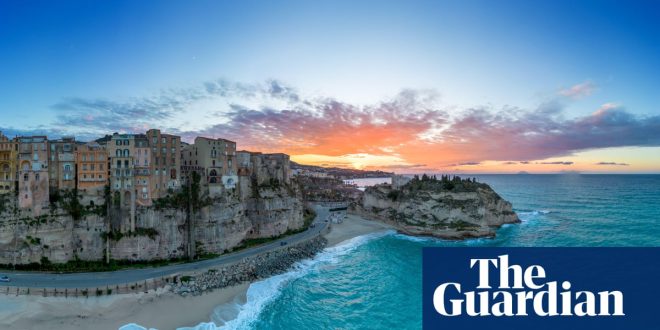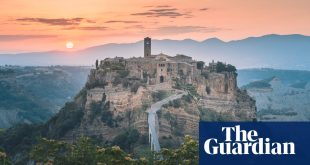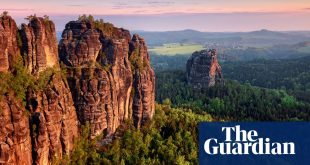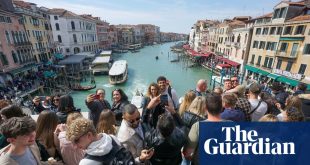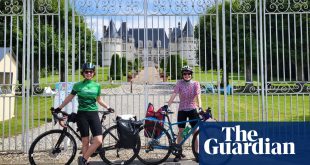Let’s start with an exclusive: “Italian town wants more tourists and cruise passengers.” It’s true that many in Italy are fed up with the country’s 22 million annual visitors, and that its most celebrated city has banned cruise liners and makes tourists pay a daily tax, but in deepest Calabria, as in several other areas, overtourism is not an issue – rather the opposite.
The main piazza in Santa Severina, a few miles from the Ionian coast, is dotted with bars and cafes beneath the walls of a Norman fortress and the dome of a Byzantine church. There’s a small formal garden leading to a terrace with wonderful views – we are more than 300 metres (980ft) high – over the Sila mountain range.
In Tuscany or Puglia, the square would be thronged with people. Here, in the mainland’s southernmost region, it’s dead quiet on a Thursday afternoon in early summer. Cruise ships sometimes put in at Crotone, 18 miles away, and a few intrepid passengers, mainly Americans, make the trek up here for lunch at Le Puzelle restaurant just outside the village. Chef Salvatore Vona’s fare is very Calabrian: unfussy, cheap and wonderful (the signature pasta dish is farfalle with yellow peppers and the revered red onions from Tropea, on Calabria’s other coast). According to the most recent official tourist board figures (from 2022), the number of UK arrivals in Crotone was 57. One of those arrivals stayed.
I’m sharing the view on this sunny day with Niall Allsopp, Northern Irish by birth, he was a stalwart of the 1990s Madchester scene, and is now a Santa Severina resident and author of Calabria: Travels in the Toe of Italy.
Here’s one view he doesn’t share – the stereotypical perception of Calabria. Which is? He sighs: “The pits, the arsehole of Italy. Unsophisticated and uninviting, home to ruffians, kidnappers and brigands.”
Anatomically, that’s some way off: Calabria is Italy’s toe. But let’s see how accurate the rest is, starting with the brigands. The unification of Italy in 1861 did not unite the country economically. People in the north did well; the many times colonised (Brutti-Bourbon-Greek–Norman-Spanish-Lombard) peninsula of Calabria did not.
“The Kingdom of the Two Sicilies – everything south of Naples – was the economic hub of what later became Italy,” says Allsopp. “The wealth of the south was transferred north after 1860. The south took exception to this. Hence brigandage and banditry. It is no coincidence that the mafia came to the fore in the same period.”
Yes, Calabria was and is the home of the ’Ndrangheta mob.
Santa Severina is not. It has a sign saying: “Qui la ’ndrageta no entra. I comuni calabresi ripudiano la mafia in ogni sua forma.” You get the gist. They are not welcome in this town. You can tell the towns where they are, says Allsopp. They’re the drab, mean ones that no one wants to visit.
That list does not include Tropea, Calabria’s undoubted success story, which is a couple of hours west on the Tyrrhenian Sea, looking out to Sicily and the Aeolian islands.
The route into Tropea from the north looks like a straight coast road on the map, but the vertiginous cliffs and inaccessible bays force you up and down and round hairpin bends.
Eventually, you reach the old town centre, only to find you are hundreds of feet above the beaches, which are reached by a calf-straining footpath. But from above, you get a hell of a photo. You look down on pale sand meeting clear emerald water. It’s hard to picture a better town beach.
A classic southern Italian town of formal architecture, hot squares and shady sidestreets, Tropea is busy and cheerful, but has nothing flash about it. This is no Sorrento or Portofino.
For those who want sun and sand, hotels 15 minutes from town cost a fraction of the price of similar places in Amalfi: the Baia del Sol, (doubles from €124 B&B) for example, is great for families, while the plush Capovaticano Spa Thalassotherapy is aimed more at couples (from €260). I heard plenty of German spoken, a little French and Danish – but no English.
Just down the coast, Capo Vaticano has sunset views that merit the word epic: the volcanic island of Stromboli, wreathed in smoke and clouds, is straight ahead, and far to the south is the perfect peak of Etna in Sicily. With its sultry skies, lush undergrowth and somewhat sketchy infrastructure, the coast reminds me of the less developed Caribbean islands.
The city of Reggio Calabria is an interesting, if tortuous, 90-minute drive to the south. Visitors to its National Archaeological Museum of Reggio Calabria currently have to settle for looking at its celebrated Riace bronzes, made in about 450BC, through a glass pane. Inside, the archaeologists have their laptops and cameras set up while they try to resolve the several mysteries about the figures’ origins.
The museum is well worth a tour, however, as is the restored seafront, named in honour of Italo Falcomatà, the mayor whose 1990s rehabilitation projects, known as the Reggio spring, created the city’s smart new centre in defiance of the mob.
It’s a two-hour drive on the imperfect A3 motorway from Tropea into the mountainous Pollino national park and the Locanda del Parco agriturismo. From the start we can tell it’s not your usual farm stay. Just beyond the chicken coop sits a dusty London taxi. Its owner, Gaetano, took a cab ride while he was in England for a conference, and learned from the driver that the vehicle was for sale. He bought it and drove it all the way home. Its boot is now a flower bed.
The Locanda is a sweet, relaxed and slightly bonkers place. There are crooked wooden signs, old tools and a big smile from Adriana, the co-owner, who whisks us straight off to pick some courgettes for lunch.
The guest rooms, like the house itself, are a defiantly unmodernised clutter of old pictures, odd pieces of furniture and family mementoes. The exception is a spacious suite with sitting room and terrace by the swimming pool: it costs from €160 a night. Rooms in the farmhouse or in a cottage amid olive groves and vegetable patches start at €106.
All the food they serve is from the property. Everything you make is too, as the owners also offer cookery classes, which are an excellent reason to visit. Lessons are held in a small room off the main kitchen with a big table, huge bunches of dried chillis hanging from the ceiling and a flipchart announcing what we’ll be preparing for lunch.
First, there’s polenta tipica, with sweet peppers and vegetables. Then there are the flowers of the courgettes we picked, fried and stuffed with ricotta (Calabrians love their ricotta). Finally, we make pipazzo, the sun-dried tomato paste Calabrians put on everything – including the pasta we make with spicy ’nduja. This spreadable salami is the signature taste of Calabria, a bit exotic and very upfront – a bit like the region itself.
Nearby Morano Calabro is another hilltop town to make the Chianti classes swoon, with a castle. The Normans arrived in Calabria six decades before the battle of Hastings. (Given the choice of a posting in, say, 11th-century north Wales or Calabria, I think I’d have opted for the latter.)
I leave thinking that Calabria is as much a country as a region – and needs more than one return visit. No need to worry about overtourism just yet.
Accommodation was provided by Baia del Sole and Capovaticano resort. More information from Calabria Tourism
 Top Naija News – Nigeria News, Nigerian News & Top Stories Top Naija News – Nigerian Newspapers, Nigerian News. topnaijanews is a daily Nigerian newspaper covering Latest News, Breaking News, Entertainment, Sports, Lifestyle and Politics.
Top Naija News – Nigeria News, Nigerian News & Top Stories Top Naija News – Nigerian Newspapers, Nigerian News. topnaijanews is a daily Nigerian newspaper covering Latest News, Breaking News, Entertainment, Sports, Lifestyle and Politics.
